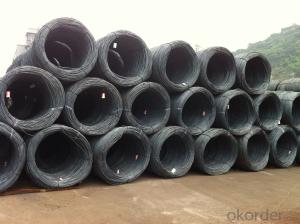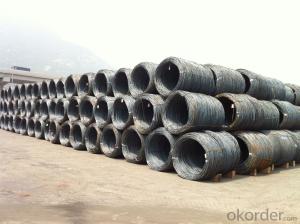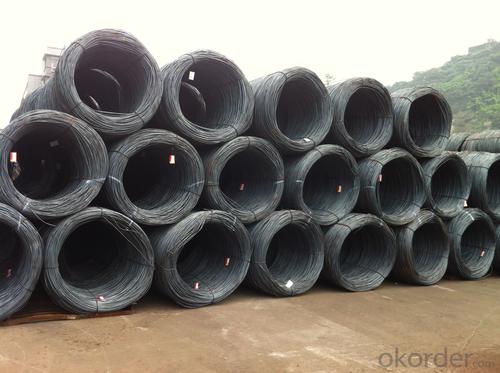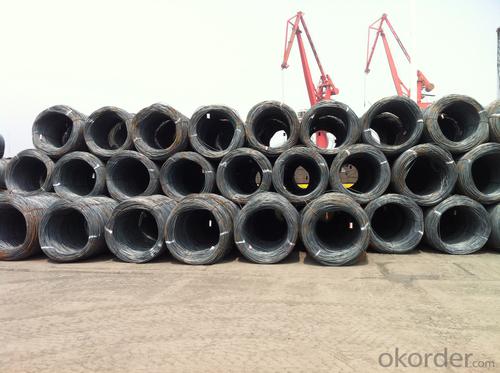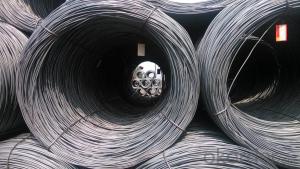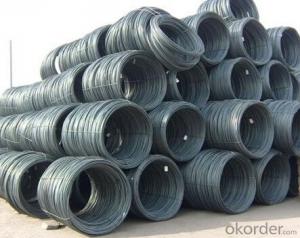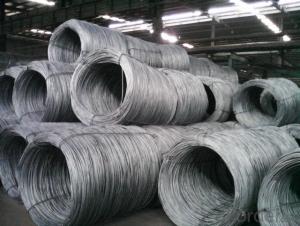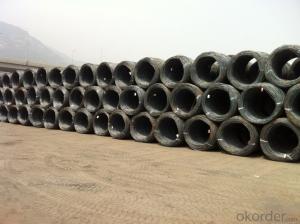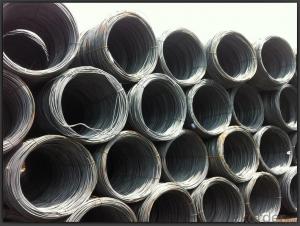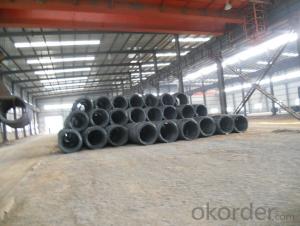Hot Rolled Steel Wire rods in Grade SAE1008B
- Loading Port:
- Tianjin
- Payment Terms:
- TT OR LC
- Min Order Qty:
- 25 m.t
- Supply Capability:
- 10000 m.t/month
OKorder Service Pledge
OKorder Financial Service
You Might Also Like
OKorder is offering Carbon Steel Wire Rod at great prices with worldwide shipping. Our supplier is a world-class manufacturer of steel, with our products utilized the world over. OKorder annually supplies products to European, North American and Asian markets. We provide quotations within 24 hours of receiving an inquiry and guarantee competitive prices.
Product Applications:
Carbon Steel Wire Rod are ideal for structural applications and are widely used in the construction of buildings and bridges, and the manufacturing, petrochemical, and transportation industries.After hot-rolled the products shaped into coil and delivery as finished product, including round, square, rectangular, hexagonal and so on. Since most of the products are round, it is generally called wire rod. Carbon steel wire rod is widely used in construction and manufacturing. Carbon steel wire rod is mainly used for reinforcement of reinforced concrete and welded structure or reprocessed (roberts , nail, etc.) materials, especially used to produce wire drawing, welding electrode, nails, spring, electronic, precise machinery parts and so on.
Product Advantages:
OKorder's Carbon Steel Wire Rod are durable, strong, and resist corrosion.
Main Product Features:
· Premium quality
· Prompt delivery & seaworthy packing (30 days after receiving deposit)
· Corrosion resistance
· Can be recycled and reused
· Mill test certification
· Professional Service
· Competitive pricing
Product Specifications:
Chemical Composition:
Please kindly find our chemistry of our material based on SAE1006/SAE1008 as below for your information
Grade | Chemical Composition (%) | |||||
C | Mn | S | P | Si | B | |
SAE1006B | 0.03~O.07 | 0.32max | 0.045max | 0.040max | 0.30max | 0.0008min |
Mechanical properties | ||||||
Yield strength(N/mm2) | Tensile strength(N/mm2) | Elongation (%) | ||||
250-280 | 350-380 | ≥32 | ||||
Grade | Chemical Composition (%) | |||||
C | Mn | S | P | Si | B | |
SAE1008B | 0.10max | 0.3~0.50 | 0.050max | 0.040 max | 0.15max | 0.0008 min |
Mechanical properties | ||||||
Yield strength(N/mm2) | Tensile strength(N/mm2) | Elongation (%) | ||||
≥195 | 315-430 | ≥30 | ||||
FAQ:
Q1: Why buy Materials & Equipment from OKorder.com?
A1: All products offered by OKorder.com are carefully selected from China's most reliable manufacturing enterprises. Through its ISO certifications, OKorder.com adheres to the highest standards and a commitment to supply chain safety and customer satisfaction.
Q2: Can stainless steel rust?
A2: Stainless does not "rust" as you think of regular steel rusting with a red oxide on the surface that flakes off. If you see red rust it is probably due to some iron particles that have contaminated the surface of the stainless steel and it is these iron particles that are rusting. Look at the source of the rusting and see if you can remove it from the surface.
Q3: How soon can we receive the product after purchase?
A3: Within three days of placing an order, we will begin production. The specific shipping date is dependent upon international and government factors, but is typically 7 to 10 workdays.
Image:
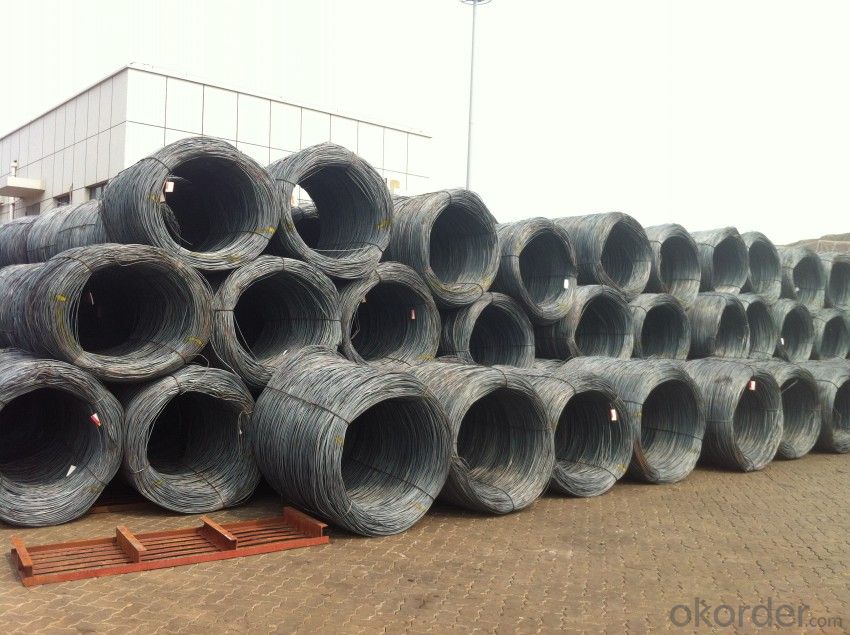
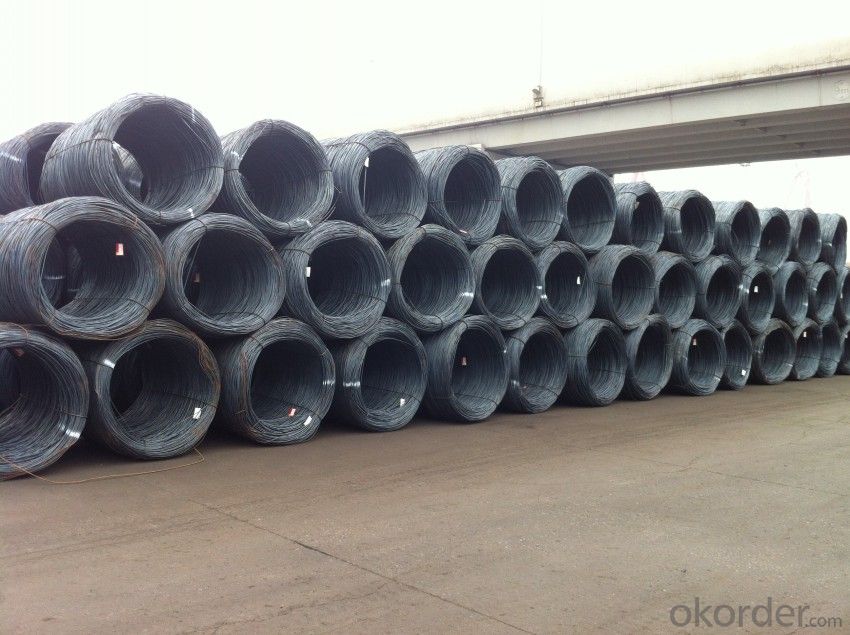
- Q: What are the major challenges faced by the steel wire rod industry?
- The steel wire rod industry faces several major challenges in today's market. One of the significant challenges is the fluctuation in raw material prices, particularly that of iron ore and coal. The steel wire rod production heavily relies on these inputs, and any significant price increase can impact the overall cost of production. Another challenge is the intense global competition. Steel wire rod manufacturers face competition from both domestic and international players. This competition puts pressure on manufacturers to constantly improve their production efficiency, reduce costs, and enhance product quality to stay competitive. Furthermore, environmental regulations and sustainability concerns pose a challenge to the industry. Steel wire rod production involves energy-intensive processes, which can lead to high carbon emissions. As governments and consumers increasingly prioritize sustainability, steel wire rod manufacturers need to invest in cleaner technologies and adopt eco-friendly practices to reduce their carbon footprint. Moreover, the fluctuating demand for steel wire rods can be a challenge for the industry. Steel wire rods are used in various sectors such as construction, automotive, and manufacturing. The demand for these sectors is subject to economic cycles and external factors such as government policies, infrastructure projects, and consumer spending. Therefore, manufacturers need to closely monitor market trends and adjust their production accordingly to avoid overproduction or underutilization of capacity. Additionally, the industry faces the challenge of technological advancements. With the rise of automation and digitalization, steel wire rod manufacturers need to invest in advanced technologies to improve production efficiency, reduce downtime, and enhance product quality. This requires significant capital investment and skilled labor, which can be a challenge for some companies. Lastly, the industry needs to address the issue of counterfeit products. Counterfeit steel wire rods can pose significant safety risks to end-users. Manufacturers need to implement strict quality control measures and work closely with regulatory authorities to prevent the circulation of counterfeit products in the market. In conclusion, the steel wire rod industry faces challenges such as fluctuating raw material prices, intense global competition, environmental regulations, fluctuating demand, technological advancements, and the issue of counterfeit products. Overcoming these challenges requires continuous innovation, strategic planning, and a focus on sustainability to ensure the long-term success of the industry.
- Q: How is steel wire rod used in the production of wire ropes for ski lifts?
- Steel wire rod is an essential component in the production of wire ropes for ski lifts. The wire rod serves as the raw material from which the wire ropes are manufactured. To begin with, the steel wire rod is carefully selected for its specific properties, such as strength, durability, and flexibility. These characteristics are crucial for ensuring the wire ropes can withstand the heavy loads and constant usage associated with ski lift operations. Once the appropriate steel wire rod is obtained, it undergoes a series of processes to transform it into wire ropes. The wire rod is first cleaned and then heated to a specific temperature to improve its malleability. It is then passed through a series of dies to gradually reduce its diameter and shape it into a continuous length of wire. Next, the individual wires are twisted together to form strands. This twisting process, known as stranding, can vary in configuration depending on the desired strength and flexibility of the wire rope. The strands are then compacted and laid together around a central core, forming the final wire rope structure. The use of steel wire rod in the production of wire ropes for ski lifts offers several advantages. Firstly, steel is known for its high tensile strength, allowing the wire ropes to support heavy loads and provide a safe transportation system for skiers. Additionally, the durability of steel ensures that the wire ropes can withstand the harsh weather conditions and constant exposure to extreme temperatures on mountain slopes. Furthermore, the flexibility of steel wire rod allows the wire ropes to bend and conform to the pulleys and sheaves used in ski lift systems, ensuring smooth and reliable operation. This flexibility is vital in preventing any sudden failure or damage to the wire ropes during their continuous usage. In conclusion, the use of steel wire rod in the production of wire ropes for ski lifts is paramount to ensure the safety, reliability, and durability of these transportation systems. The properties of steel, such as its strength and flexibility, make it an ideal material for constructing wire ropes that can withstand the demanding conditions of ski lift operations.
- Q: What are the requirements for steel wire rod used in cable-stayed bridge wire strands?
- The requirements for steel wire rod used in cable-stayed bridge wire strands are typically stringent due to the critical nature of these components in ensuring the safety and structural integrity of the bridge. Here are some of the key requirements for steel wire rod used in cable-stayed bridge wire strands: 1. Material Composition: The steel wire rod must be made from high-quality, high-strength steel with specific chemical composition requirements. This is to ensure the wire's ability to withstand the loads and stresses it will experience in the cable-stayed bridge. 2. Tensile Strength: The wire rod must have a minimum tensile strength that meets the design requirements of the cable-stayed bridge. This ensures that it can withstand the tension forces exerted on it without deformation or failure. 3. Ductility: The steel wire rod must possess sufficient ductility to allow for bending and shaping without fracturing or losing its strength properties. This is important during the fabrication and installation processes of the wire strands. 4. Uniformity and Consistency: The wire rod should have uniform and consistent material properties throughout its length. This is crucial to ensure consistent performance and behavior of the wire strands under various loading conditions. 5. Surface Quality: The surface of the wire rod must be smooth and free from defects such as cracks, scratches, or other surface irregularities. This is necessary to prevent stress concentration points or potential failure initiation sites. 6. Dimensional Accuracy: The wire rod should meet specific dimensional tolerances to ensure proper fit and compatibility with the cable-stayed bridge design. This includes diameter, roundness, and straightness requirements. 7. Corrosion Resistance: The wire rod must possess good corrosion resistance properties to withstand exposure to environmental conditions, including moisture, humidity, and chemicals. This helps to ensure the long-term durability and safety of the wire strands. 8. Certification and Testing: The steel wire rod used in cable-stayed bridge wire strands must be produced by reputable manufacturers and should be accompanied by relevant certifications and test reports. These documents provide assurance that the wire rod meets the specified requirements and has undergone necessary quality control measures. It is important to note that specific project requirements and design standards may vary, and the above requirements may not be exhaustive. Consulting the applicable design codes and specifications for cable-stayed bridges is essential to ensure compliance with the project-specific requirements.
- Q: What are the major suppliers of steel wire rod?
- Some of the major suppliers of steel wire rod include ArcelorMittal, Nippon Steel Corporation, POSCO, Tata Steel, and JFE Steel Corporation.
- Q: How is steel wire rod used in the manufacturing of wire ties for construction sites?
- Steel wire rod is used in the manufacturing of wire ties for construction sites by being drawn through a series of dies to reduce its diameter and increase its length. This process results in a strong and durable wire that is then cut into the desired lengths and bent into the shape of wire ties. These wire ties are widely used in construction sites to secure and hold together various building materials, such as rebar, pipes, or electrical wires, ensuring structural stability and safety.
- Q: How are steel wire rods used in the manufacturing of piano strings?
- Piano strings are made using steel wire rods, which are essential for their production. The strength and durability of steel make it an ideal material for creating strings that can handle the high tension required to produce the desired sound in a piano. To start the manufacturing process, careful selection is done to choose high-quality steel wire rods with specific properties. These rods are typically made of high-carbon steel, providing the necessary strength and resilience for piano strings. Once the steel wire rods are selected, they go through a series of processes to turn them into piano strings. Firstly, the rods are drawn through dies to decrease their diameter and increase their length. This wire drawing process ensures that the wire has the correct thickness for the desired pitch of the piano string. After wire drawing, the steel wire rods undergo annealing and tempering. Annealing involves heating the wire to a precise temperature and then slowly cooling it, enhancing flexibility and reducing internal stresses. On the other hand, tempering includes reheating the wire to a lower temperature and rapidly cooling it, improving its strength and elasticity. Once the steel wire rods have been annealed and tempered, they are ready to be transformed into piano strings. The wire is cut into specific lengths and tightly wound around a core wire, usually made of copper or steel. The winding process is carefully controlled to ensure uniformity and precision in the string's diameter and tension. Finally, the wound strings undergo additional processes like polishing and coating to enhance their durability and tonal quality. These processes protect the strings from corrosion and wear, ensuring that they maintain their sound and longevity over time. In conclusion, steel wire rods are utilized in the manufacturing of piano strings due to their high tensile strength and durability. Through processes like wire drawing, annealing, tempering, and winding, these steel rods are transformed into strings that can withstand high tension and produce the desired sound in a piano.
- Q: What are the different surface marking materials used for steel wire rod?
- There are several different surface marking materials that can be used for steel wire rod. These materials are applied to the surface of the wire rod to provide identification and traceability. Some of the commonly used surface marking materials include: 1. Paint: Paint is one of the most common surface marking materials used for steel wire rod. It is applied in the form of a coating and can be used to mark various information such as product identification, grade, and manufacturer's logo. Paint markings are typically durable and can withstand normal handling and transportation. 2. Ink: Ink is another commonly used surface marking material for steel wire rod. It is applied using a printing process and can be used to mark various information such as product specifications, lot numbers, and barcodes. Ink markings are generally resistant to abrasion and can provide high-contrast visibility. 3. Hot stamping: Hot stamping is a process in which a marking foil is applied to the surface of the steel wire rod using heat and pressure. This technique allows for the transfer of pre-printed information onto the surface of the wire rod. Hot stamping is often used to mark important information such as heat numbers, production dates, and customer-specific requirements. 4. Laser marking: Laser marking is a non-contact marking process that uses a laser beam to create permanent markings on the surface of the steel wire rod. It is a precise and versatile marking method that can be used to engrave various information such as logos, serial numbers, and part numbers. Laser markings are highly durable and resistant to fading, making them suitable for long-term identification. 5. Etching: Etching is a chemical process that involves the removal of a thin layer of material from the surface of the steel wire rod. It is commonly used to create indented markings that can be filled with paint or ink for increased visibility. Etched markings are resistant to abrasion and can provide a long-lasting identification solution. Overall, the choice of surface marking material for steel wire rod depends on factors such as the required durability, visibility, and specific application requirements. Each of these materials has its own advantages and can be tailored to meet the specific needs of the wire rod manufacturer and end-user.
- Q: What are the different international standards for steel wire rod?
- There are several international standards for steel wire rod that have been established by various organizations and regulatory bodies. These standards ensure that steel wire rod meets the necessary quality and performance requirements for different applications. Some of the most widely recognized international standards for steel wire rod include: 1. ISO 16120-1:2011 - This standard specifies the general requirements for steel wire rod, including dimensions, tolerances, and mechanical properties. It covers both carbon and alloy steel wire rod. 2. ASTM A510/A510M - This standard is published by the American Society for Testing and Materials (ASTM) and provides the requirements for carbon and alloy steel wire rod. It covers various grades and specifies the chemical composition, mechanical properties, and dimensional tolerances. 3. JIS G 3503 - This Japanese industrial standard defines the requirements for low carbon steel wire rods for general use. It specifies the chemical composition, mechanical properties, and dimensional tolerances. 4. BS EN 10016-2:2017 - This European standard specifies the technical delivery conditions for non-alloy steel wire rod for cold heading and cold extrusion. It covers the chemical composition, mechanical properties, and dimensional tolerances. 5. DIN 17140:1976 - This German standard provides the technical delivery conditions for unalloyed steel wire rod for general purposes. It specifies the chemical composition, mechanical properties, and dimensional tolerances. These international standards serve as guidelines for manufacturers, suppliers, and customers in the steel wire rod industry. They ensure that the product meets the necessary quality standards and can be used reliably in various applications such as automotive, construction, and manufacturing.
- Q: What are the common industry associations for steel wire rod?
- Some common industry associations for steel wire rod include the American Wire Producers Association (AWPA), the Steel Manufacturers Association (SMA), and the International Wire and Machinery Association (IWMA). These associations work towards promoting the steel wire rod industry, addressing industry challenges, setting standards, and providing a platform for networking and knowledge sharing among industry professionals.
- Q: What are the common production processes for hydrogen-coated steel wire rod?
- The common production processes for hydrogen-coated steel wire rod include pickling, drawing, coating with hydrogen, and annealing.
Send your message to us
Hot Rolled Steel Wire rods in Grade SAE1008B
- Loading Port:
- Tianjin
- Payment Terms:
- TT OR LC
- Min Order Qty:
- 25 m.t
- Supply Capability:
- 10000 m.t/month
OKorder Service Pledge
OKorder Financial Service
Similar products
Hot products
Hot Searches
Related keywords
